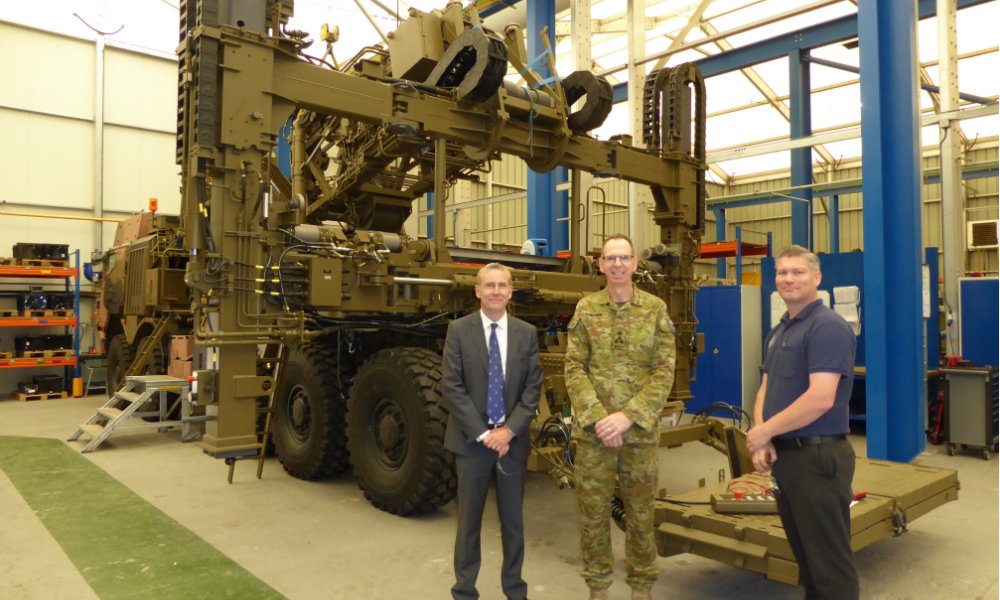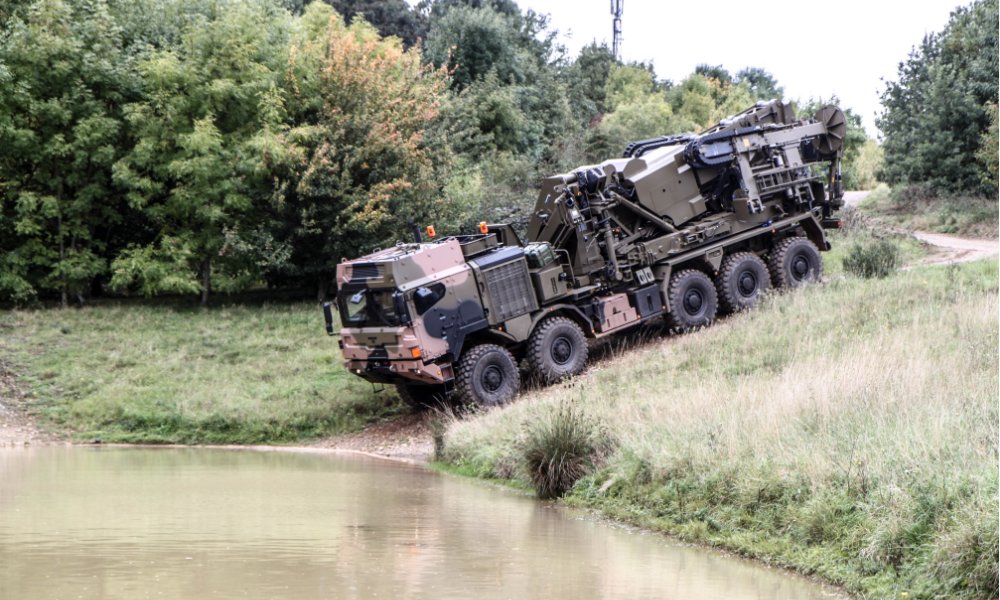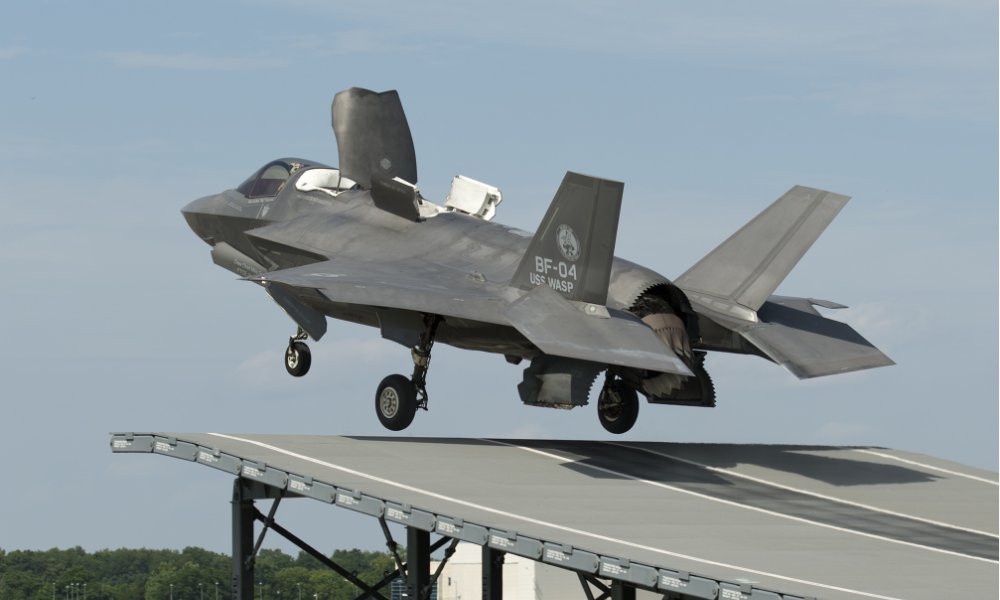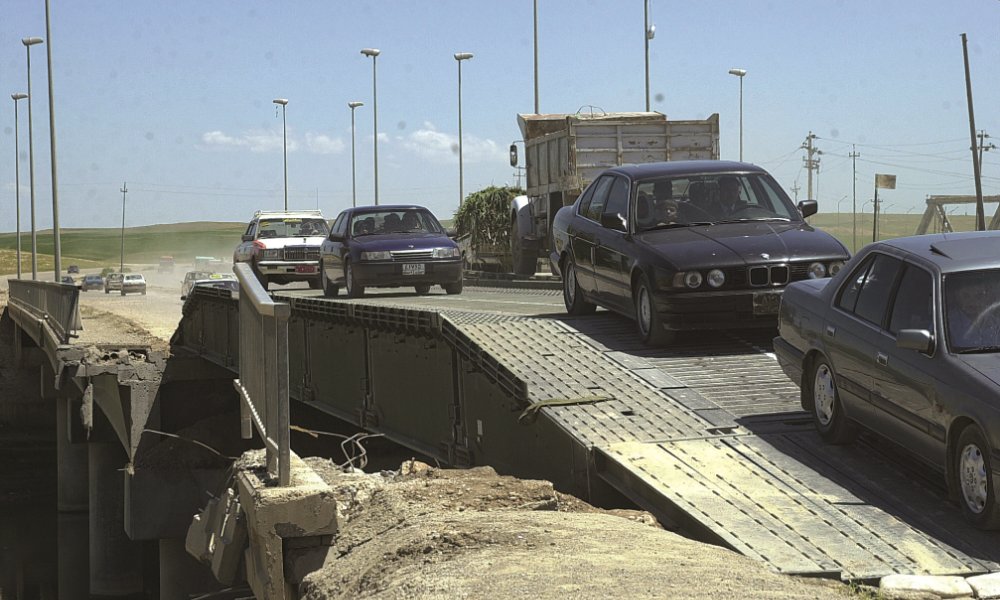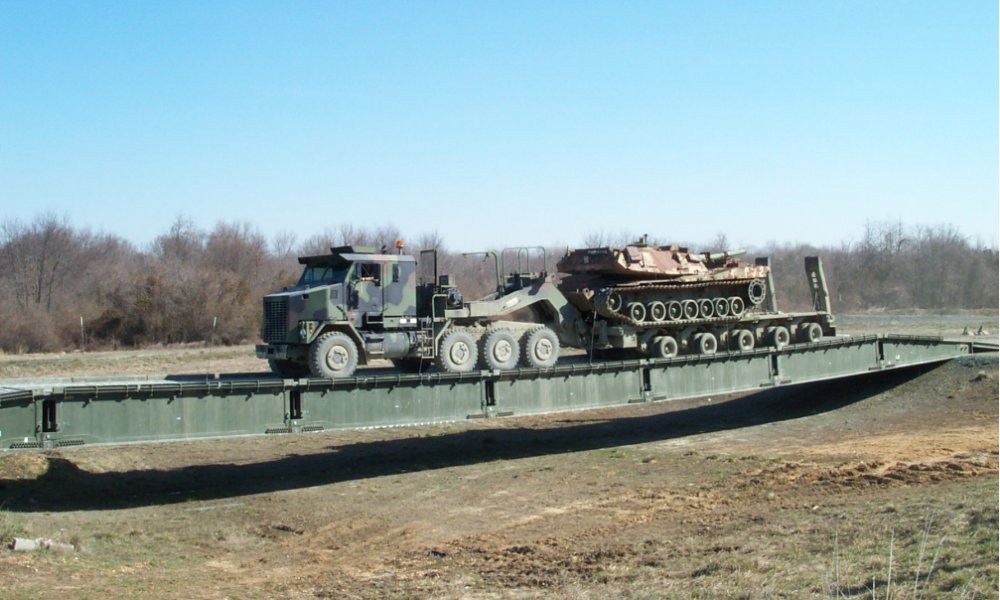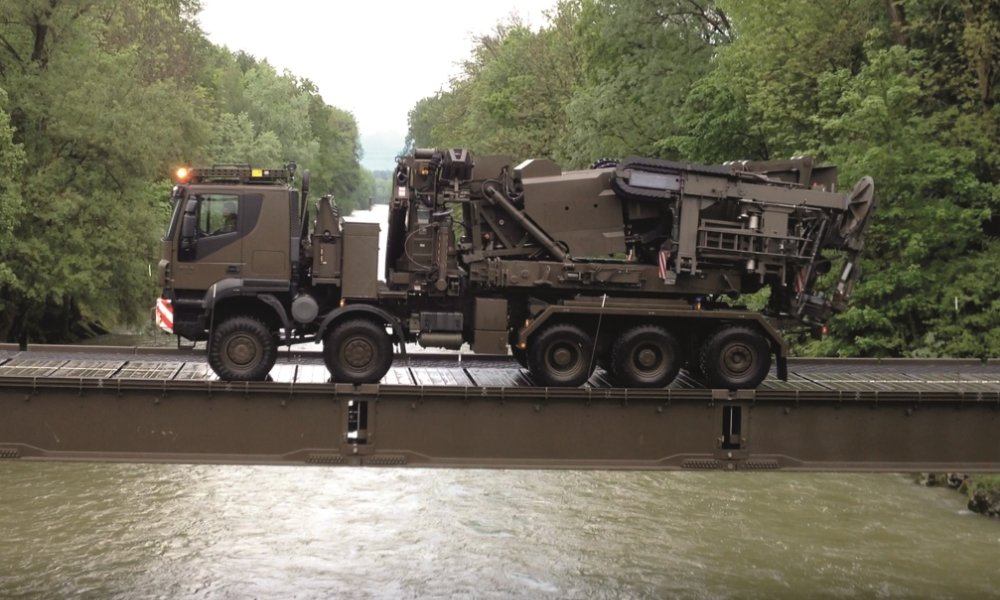THE F-35 INTEGRATED TEST FORCE AT NAS PATUXENT RIVER IS ONCE AGAIN CONDUCTING LAND-BASED SKI-RAMP TESTING IN PREPARATION FOR TRIALS ON HMS QUEEN ELIZABETH PLANNED FOR 2018, USING THE TAKE-OFF RAMP WHICH WFEL DESIGNED, DEVELOPED AND MANUFACTURED.
The following special report by Richard Scott was recently featured in Jane’s International Defence Review and is published here with kind permission from IHS Jane’s.
The idea of using a ramp to improve short take-off (STO) performance from a carrier flight deck is generally credited to a thesis completed by Lieutenant Commander Doug Taylor RN in 1973. His research project at the University of Southampton, which was exploring options to improve the operation of fixed-wing vertical/short take-off and landing aircraft from confined spaces, theorised the benefits of introducing a curved ramp or ‘ski-jump’ at the forward end of the flight deck.
Lt Cdr Taylor’s calculations identified that the effect of the ramp was to allow an aircraft such as the Harrier — powered by a vectored thrust engine using swivelling nozzles — to launch upwards on a semi-ballistic trajectory at a speed somewhat less than that required for a ‘flat deck’ STO. This translated to a shorter deck run, higher launch weight, or both.
Work on the ramp concept was further advanced by Hawker Siddeley Aviation’s Kingston division in co-operation with the Ministry of Defence (MoD) through computer modelling and simulation work. These studies confirmed the predicted performance gains and led to the actual flight testing in 1977 using an adjustable ramp constructed at the Royal Aircraft Establishment’s test facility at Bedford.
The trials, which were performed at exit settings ranging from 6.5° through to 20°, provided conclusive evidence of the benefits afforded to Harrier performance. The Royal Navy’s new carrier (CVS) HMS Invincible, by then nearing completion, was modified in build to receive a 7° ski-jump, as was second-of-class HMS Illustrious. A 12° ramp was fitted to HMS Hermes at refit, and the design of HMS Ark Royal modified to accommodate a similarly angled ramp; Invincible and Illustrious later received 12° ramps during refit.
On 30 October 1980, a Sea Harrier FRS.1 became the first fixed-wing short take-off vertical landing (STOVL) aircraft to launch from Invincible. This marked the first aircraft launch from a ski-jump at sea.
Forty years on from those first flight tests at Bedford, land-based testing is currently underway at Naval Air Station (NAS) Patuxent River, Maryland, to refine the ski-jump manoeuvre for the Royal Navy’s new Queen Elizabeth class (QEC) aircraft carriers. This activity, using the F-35B variant of the Lightning II strike fighter, is building evidence ahead of fixed-wing First of Class Flight Trials (FOCFT) on HMS Queen Elizabeth scheduled for late 2018.
The ski-jump ramp works by imparting an upward vertical velocity and ballistic profile to the aircraft, providing additional time to accelerate to flying speed while ensuring it is on a safe trajectory. This additional time is manifested either in a reduced take-off length for a given weight, or increased launch weight (fuel and/or ordnance) for a fixed take-off distance.
This additional performance does not come for free, however, with a significant increase in landing gear loads above those of a standard take-off (albeit low compared with a landing). The increase represents the energy transferred to the aircraft as it translates up the ramp; and if the angle and curvature of the ramp are increased to obtain greater performance benefit, so are the loads.
Although the basic physics of a Ski Jump STO remained unchanged, the F-35B pilot has the big advantage of being able to rely on technology rather than technique, according to Pete ‘Wizzer’ Wilson, BAE Systems F-35 STOVL lead test pilot. “The single key difference between a ski-jump in the Harrier [and] the F-35B is the pilot action right at the end of the ski-jump, just as the aircraft is becoming airborne,” he told Jane’s. “In the Harrier, the pilot had to manually move the nozzles “downwards” at the correct time. In the [F-35B], the control law does it automatically.
“While this may sound like a relatively small change, it’s actually very significant. One of the often talked about problems with the Harrier was the fact that it had three levers for the pilot to control with two hands: the stick, the throttle, and the nozzle lever. While the pilot’s right hand was enough to control aircraft attitude with the stick, it was quite common for the pilot to make a mistake with the left hand, which was required to operate both the throttle and the nozzle lever. This led to many accidents, scattered through the history of Harrier operations.”
The F-35B is very different, with a throttle on the left and a stick on the right. Software — embodied in the aircraft’s advanced control law — takes care of the rest. “Push the throttle to full power, release the brakes, and steer towards the centre of the ski-jump. That, in a nutshell, is what the F-35B pilot has to do during a ski-jump launch,” said Wilson.
“The Ski Jump STO mode requires no action on the part of the pilot other than to ensure the aircraft is steered up the ski-jump. This is a crucial piece of the design since it means the pilot can’t make the mistake of selecting the ‘wrong’ type of take-off, for example selecting a Ski Jump STO when it is actually a Flat Deck STO.”
It is a far cry from the busy cockpit of the Harrier, where the pilot needed to set the correct trim setting before releasing the brakes, move the left hand from the throttle to the nozzle lever after pushing the throttle to full power, and then adjust the nozzles downward at just the right time. The Harrier’s flyaway characteristics were also less predictable. “It was not uncommon to have to control angle of attack once airborne,” Wilson said. “The automatics of the F-35B make the ski-jump launch extremely straightforward for the pilot; in contrast, the Harrier was much higher workload and comparatively much higher risk.”
QinetiQ flight test engineer Gordon Stewart, who has spent much of the last five years attached to the joint US/UK F-35 Integrated Test Force at Patuxent River, points out that making STOVL easy was an important design consideration for the F-35B control law. “Because of the high level of automation embodied, a ski-jump launch is in fact the most straightforward take-off manoeuvre for the STOVL variant of the Lightning II,” he explained to a Royal Aeronautical Society audience in May this year. “When the pilot slams the throttle, the control law is configuring the aircraft for maximum acceleration.”
At the point the aircraft accelerates up the ramp, the control law detects the change in pitch rate and attitude. “That’s the point where it transitions into ski-jump mode,” Stewart said. “Once that occurs, the aircraft has approximately one second to transition to flyaway.”
During that brief period, the control law is configuring the aircraft to minimise the pitch transient on exiting the ramp. It achieves this by setting the horizontal tail position, repositioning the angle of the engine nozzle, and changing the balance/rate of thrust between the lift fan and the aft nozzle. “The thrust split moves forward on the ramp, then back after exit,” said Stewart. “That rapid change in ratio to balance [the aircraft in airborne flight] reflects what’s happening coming off the ramp.
The aircraft is controlling the pitch attitude off the ramp [and is] effectively ‘open loop’ for a very short period of time afterwards.” As part of the F-35 System Design and Development phase, a land-based ski-ramp — modelled on the legacy design used in the RN’s earlier Invincible-class CVS — has been built at Patuxent River to support UK testing. Initial testing was focused on assessing the F-35B’s flying qualities, performance, and undercarriage response during a ramp-assisted take-off.
Test plan development for these Phase 1 Ski Jump STO trials began in earnest back in 2014 using offline and manual simulation. “We started control room training [for the flight test team] and mission rehearsals at the end of the year,” Stewart said. “We performed literally tens of thousands of offline runs in the simulator. That allowed us to look at variations across a whole range of parameters, and also allowed us to develop our launch planning tool.”
Work then switched to the manned simulator at Patuxent River, where the test team assessed various failure cases with a pilot-in-the-loop. “Examples included a large wind drop at ramp exit, a blown tyre or nosewheel steering failure, aircraft system and surface failures, a partial loss of thrust, and an inadvertent short take-off before the ramp,” Stewart said. “We also looked at our robustness to certain issues or conditions — for example, crosswind off the ramp. This helped us flush out a number of minor control law features.”
A first launch from the ski ramp at NAS Patuxent River had been planned for February 2015, but inclement weather conditions and ‘slot’ availability saw this slip to mid-year. “Specific planning for that first launch determined that [aircraft] air speed should be no slower than a previous flat deck launch at similar weight,” said Stewart. “We also put an extra 10% margin on gear load, and a 0.5% extra margin on gear stroke.
“As regards to wind limits, our plan said no tailwind, a maximum 20 kt headwind, and a maximum 8 kt crosswind.” Wilson performed the first ski-jump STO on 19 June 2015, flying development aircraft BF-04. “The results of that first launch brought out a couple of things,” he said. “We had slightly more pitch up than predicted after ramp exit, and the gear extended faster than predicted.”
A second launch was performed in similar conditions to the first test but at a slower entry speed. Once again, the aircraft pitched up more than expected, said Stewart. “Our modelling hadn’t predicted that ... the results showed different pitching moments near the ramp exit. We found those ‘missing’ moments and injected them into the simulation.” Another 19 launches were performed in September–October 2015 using BF-01 and BF-04.
“These flight tests, performed with the same control law version, were executed no slower than 65 kt at ramp exit,” Stewart explained. “By keeping the speed up we avoided those pitch-up issues.” Informed by the data captured in Phase 1 testing, the aircraft model was updated and the control law refinements implemented. “One consequence was to introduce a new thrust split schedule to ensure that the thrust can’t get too ‘far forward’,” said Stewart. “That helped with the pitch response.”
Phase 1 ski-ramp testing resumed at Patuxent River during April 2016 using the revised control law. Aircraft BF-01 and BF-04 repeated previous test points at various weights, centres of gravity, and speeds. Regression testing showed an improved pitch response better matching with models.
By the end of June 2016, a total of 31 ski-ramp take-offs had been performed to complete Phase 1 testing. Wilson explained, “We’ve done weights up to full fuel and full internal stores; forward/mid/aft centre-of-gravity positions; a range of ramp exit speeds up to 95 KCAS [knots-calibrated air speed]; line-up distances from 315 ft to 620 ft; and we’ve done mil and max power [non-afterburning and afterburning] launches.
“We learned that we had excellent models that did a good job of predicting how Ski Jump STO mode performs,” he added. “However, we saw a couple of imperfections in the modelling that we have now corrected and we also found that we were not positioning the nozzles in the optimum position under all circumstances, which has allowed us to tweak the control law and improve the mode. We discovered that the performance of the aircraft is even better than we had hoped, so we continue to refine our performance predictions.”
Phase 2 Ski Jump STO trials began at Patuxent River in June this year. “Phase 1 was really a de-risking exercise, with internal stores only,” Stewart explained. “Phase 2 includes the bulk of the test points to expand the ski-jump envelope.”
Wilson amplified, “The second trials will allow us to evaluate handling characteristics with external weapons including asymmetric weapon loads, crosswinds up to 15 kt, and overspeed/underspeed take-offs. In the order of 150 ski-jumps will be performed from the Pax ramp on this part of the programme.
“We will complete by the end of the year, most likely by the end of October. The results will be used to allow us to take relatively big steps during FOCFT, which means we’ll get through the testing at the ship much quicker and with much lower risk.”
What land-based testing will not replicate is the ski-ramp on Queen Elizabeth. “The Pax ramp is actually modelled on the 12°, 150 ft CVS ramp profile,” pointed out Wilson. “Queen Elizabeth has a longer [200 ft] two-part ramp angled at 12.5°. So there will be a little bit of the unknown there.”
He continued, “We have predictions for how the aircraft should behave from multiple ski-jump profiles, including the Pax ski-jump. By comparing the results with the predictions for the Pax ski-jump, we can have a really well-educated guess at how any slight imperfections in the control law should impact the other ski-jump profiles. Then we can tweak the control law in ways that should improve the QEC handling characteristics. “When we do this, we recognise that we might actually make the handling characteristics worse for the Pax ski-jump. But since we’re not designing for the Pax ski-jump as an in-service case, we don’t mind doing that.”


